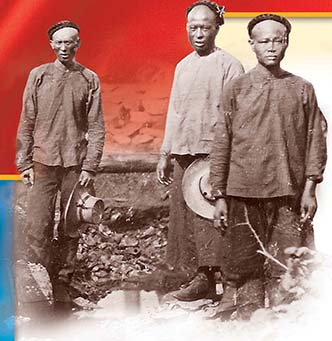SECTION 3: Effects of Territorial Expansion

▲ Chinese miners in California

Gold-mining tools ►
WITNESS HISTORY  AUDIO
AUDIO
Seeking a Mountain of Gold
By 1849, poor farmers in China had received word of a “mountain of gold” across the Pacific Ocean. Soon, thousands of Chinese men joined fortune seekers from all over the world in a rush to the gold fields of California. However, the Chinese newcomers often faced a hostile reception. In a letter home to his parents, one young American miner described the unfair treatment of Chinese miners:
“They are coming by thousands all the time The miners in a great many plases will not let them work The miners hear drove off about 200 Chinamen about two weeks ago but they have com back about as thick as ever (I would not help drive them off as I thought they had no rite to drive them).”
—Robert W. Pitkin, 1852
Objectives
- Explain the effects of the Mexican-American War on the United States.
- Trace the causes and effects of the California Gold Rush.
- Describe the political impact of California’s application for statehood.
Terms and People
- Treaty of Guadalupe Hidalgo
- Gadsden Purchase
- Wilmot Proviso
- California Gold Rush
- forty-niners
- placer mining
- hydraulic mining
NoteTaking
Reading Skill: Understand Effects Trace the effects of the Mexican-American War.

Why It Matters As a result of its quick victory in the Mexican-American War, the United States would finally achieve the expansionists’ goal of Manifest Destiny. Yet, the long-term effects of the war served to highlight growing differences between North and South and set the stage for future conflict. Section Focus Question: What were the effects of the Mexican-American War and the California Gold Rush?
America Achieves Manifest Destiny
In February 1848, the defeated Mexicans made peace with the Americans. The Treaty of Guadalupe Hidalgo (gwah duh LOO pay ee THAHL goh) forced Mexico to give up the northern third of their country and added 1.2 million square miles of territory to the United States.
The United States Gains Territory
In return for leaving Mexico City and paying $15 million, the victors kept New Mexico and California. They also secured the Rio Grande as the southern boundary of Texas.
The treaty disgusted and humiliated Mexicans, who continued for decades to feel bitterness toward the United States. The treaty also dismayed Polk, but for a different reason. After Scott captured Mexico City, the President decided that he wanted to keep more of Mexico. He blamed his negotiator, Nicholas Trist, for settling for too little. But Polk had no choice but to submit the treaty to Congress because northern public opinion would not support a longer war.




